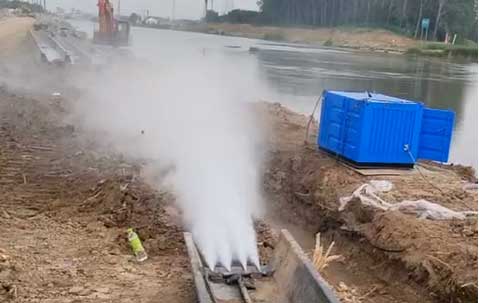▲Technical Principle
The high-pressure water stream (typically at pressures between 150-400 Bar or even higher) generated by a pump is ejected through special nozzles installed at the pile tip or along the pile side. These high-velocity water jets serve two main purposes:
1. Lubrication and Resistance Reduction: They scour the interface between the pile and the soil, creating a slurry lubrication layer that significantly reduces skin friction.
2. Cutting and Soil Breaking: They directly impact, cut, and liquefy the soil stratum below the pile tip, reducing end-bearing resistance and allowing the pile to penetrate more easily.

▲Core Application Fields
1.Application Description: This is the most classic application. When driving open-ended pipe piles or H-piles, the water jet (often inserted inside the pile or attached to its side)
simultaneously scours the soil inside and around the pile. This drastically reduces driving resistance and prevents damage or deformation of the pile head from prolonged hammering. Especially suitable for thick sand layers.
2. Application Description: Driving PHC piles into dense sand or stiff clay layers encounters enormous resistance and easily damages the pile head. Hydro jetting effectively lubricates the pile shaft, assists in penetrating hard layers, significantly improves driving efficiency, and protects the expensive piles.
3. Application Description: During the installation of interlocking sheet pile walls, especially into dense soils or gravelly layers, water jets can be directed along the pile interlocks. This reduces friction between the interlocks and soil grip, allowing the sheets to be driven more easily into position while ensuring a good interlocking seal.
4.Application Description: In construction on soft foundations or underwater (e.g., nearshore, docks, riverbanks), hydro jetting allows piles to easily penetrate fluid-like muddy soils, preventing pile instability or deviation.
5. Application Description: In certain geological conditions, high-pressure water jets can be used to replace or assist drill bits for hole formation, offering higher efficiency and lower cost.

▲Advantages
1.Increased Efficiency: Pile driving speed can be increased several times, significantly shortening the project schedule.
2.Pile Protection: Reduces driving stress and the number of blows, preventing pile head damage.
3.Penetration of Hard Strata: Capable of tackling dense layers that are difficult for conventional methods.
4.Precision and Control: Causes relatively less disturbance to the surrounding soil, aiding in pile positioning accuracy.

▲Typical Workflow Example
1. A diesel-driven high-pressure pump unit (e.g., 240bar, 200+LPM) is positioned near the piling rig. Hoses are connected to the water jet pipes that are attached to the pile.
2. As the vibratory hammer starts, the high-pressure pump is engaged. Water jets erupt at the pile tip.
3.The pile penetrates the soil rapidly with minimal resistance, aided by the water lubricating and cutting through the sand.
4. Upon reaching desired depth, water jetting is stopped, and the pile is driven to its final set using the hammer alone to ensure bearing capacity.

▲Conclusion
Hydro jetting for piling is a crucial auxiliary technique in modern foundation engineering. It perfectly combines the cutting power of high-pressure water jets with the mechanical force of traditional pile hammers, solving driving challenges in complex geological conditions. It is an effective method for improving construction efficiency, ensuring project quality, and reducing costs.

Please contact us for free quotation by form below. We promise the quickest response within 24 hours: